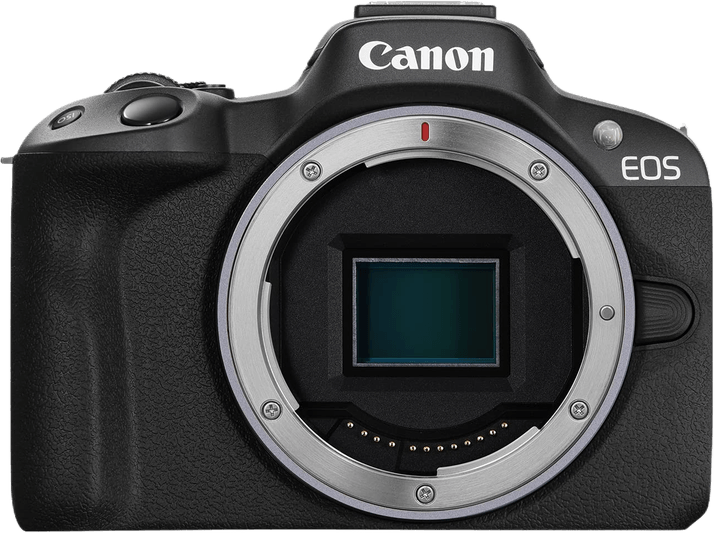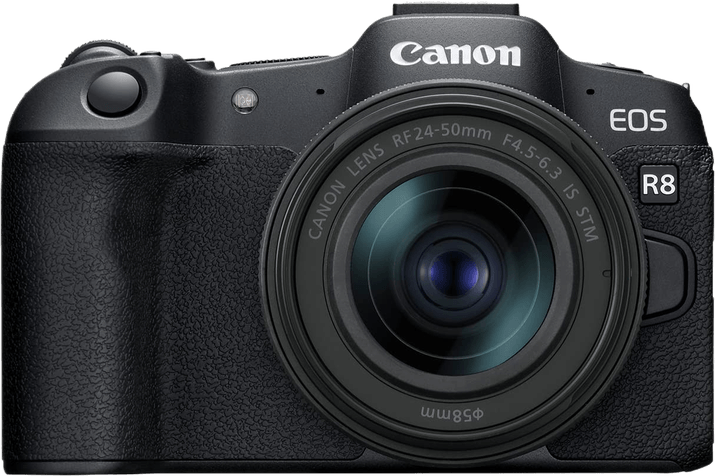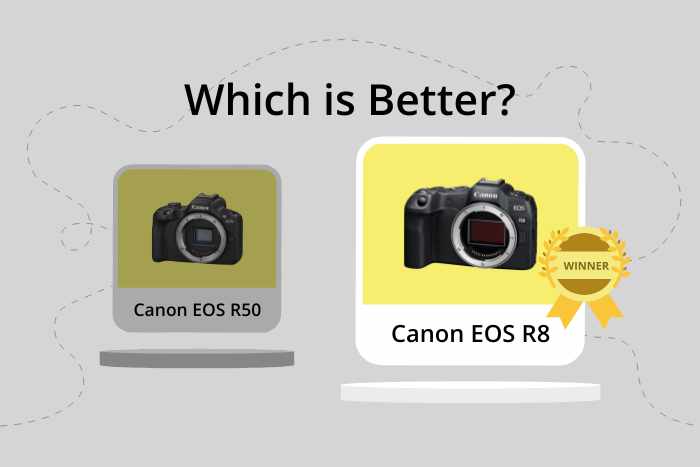Canon EOS R50 vs EOS R8 Comparison
Canon EOS R50

Canon EOS R8

The Canon EOS R8 takes the lead with a score of 76/100, while the Canon EOS R50 follows closely with a score of 70/100. Both cameras share similarities, such as being mirrorless and having the same announcement and release dates in 2023. They also have similar dimensions, with the EOS R50 measuring 116 x 86 x 69mm and the EOS R8 at 133 x 86 x 70mm.
The EOS R8 outshines the R50 with its higher score, suggesting better overall performance and features. However, the R50 has its advantages, such as a lighter weight at 375g compared to the R8’s 461g and a significantly lower launch price of $679 versus the R8’s $1499.
Taking these factors into consideration, the Canon EOS R8 proves to be a better choice for those seeking higher performance and features, while the Canon EOS R50 offers a more budget-friendly and lightweight option for photography enthusiasts.
Canon EOS R50 vs EOS R8 Overview and Optics
The Canon EOS R8 outperforms the Canon EOS R50 in optics, scoring 77/100 compared to the R50’s score of 73/100. Both cameras share several common specifications, such as 24-megapixel resolution, CMOS sensor type, Digic X processor, a DXOMARK sensor score of 94, Canon RF lens mount, and lack of image stabilization.
The EOS R8’s superiority in optics is primarily due to its full-frame sensor size, as opposed to the APS-C sensor in the EOS R50. This larger sensor allows the R8 to capture more light and produce better image quality, particularly in low-light conditions. Additionally, the R8 boasts an impressive shooting speed of 40 frames per second, significantly faster than the R50’s 12 frames per second. This makes the R8 an excellent choice for action and sports photography, where capturing fast-moving subjects is crucial.
In contrast, the EOS R50’s advantage lies in its smaller sensor size, which results in a lighter and more compact camera body. This can be beneficial for photographers who prioritize portability and ease of use. However, this advantage does not outweigh the benefits offered by the R8’s superior optics.
Taking all factors into account, the Canon EOS R8 emerges as the superior choice for photographers seeking top-notch optics. Its full-frame sensor and rapid shooting speed make it a versatile and high-performing option, while the EOS R50’s smaller sensor size limits its overall capabilities. While the R50 may offer a more portable option, the R8 delivers a higher level of performance in terms of optics, making it the clear winner in this comparison.
Canon EOS R50 vs EOS R8 Video Performance
The Canon EOS R50 and Canon EOS R8 both have a video score of 91/100, making them equally strong contenders in terms of video capabilities. Both cameras offer 4K max video resolution, with dimensions of 3840 x 2160, and have built-in time-lapse functionality.
Despite the same video scores, the Canon EOS R50 stands out with a max video frame rate of 120fps, while the Canon EOS R8 surpasses it with a max video frame rate of 180fps. This higher frame rate enables the EOS R8 to capture smoother slow-motion video, which is beneficial for those seeking to create professional-quality content.
On the other hand, the Canon EOS R50’s 120fps max video frame rate is still impressive and more than sufficient for the majority of users. With its 4K resolution, it can produce high-quality video content suitable for various purposes.
In terms of video capabilities, both cameras are reliable options. The Canon EOS R8’s higher frame rate makes it ideal for users who prioritize slow-motion video capture. However, the Canon EOS R50’s 120fps max video frame rate is still an excellent choice for most users, providing high-quality video content with its 4K resolution. Ultimately, the decision between these two cameras will depend on the user’s specific needs and preferences.
Canon EOS R50 vs EOS R8 Features and Benefits
The Canon EOS R8 emerges as the winner with a feature score of 85/100, compared to the Canon EOS R50’s score of 72/100. Both cameras share several specifications, making them quite similar in certain aspects. These common features include a 3-inch screen size, 1,620,000-dot screen resolution, touchscreen capability, flip screen, absence of GPS, and the presence of WIFI and Bluetooth connectivity.
The Canon EOS R8 outshines the R50 in certain areas, leading to its higher feature score. Unfortunately, due to the limited information provided, it is not possible to pinpoint the exact specifications that make the R8 superior. However, the higher score signifies that the R8 offers more advanced or additional features, which may contribute to a better user experience and improved performance compared to the R50.
On the other hand, the Canon EOS R50, despite having a lower feature score, may still hold an advantage in some aspects. It could be more budget-friendly or cater to specific needs that the R8 does not address. However, without further information, it is difficult to determine the exact areas where the R50 excels over the R8.
Taking into account the shared specifications and the higher feature score of the Canon EOS R8, it is evident that the R8 is a better choice for those seeking a more feature-rich camera. Meanwhile, the Canon EOS R50 may still be a suitable option for those with particular requirements or budget constraints. Ultimately, the choice between the two cameras will depend on individual preferences and needs.
Canon EOS R50 vs EOS R8 Storage and Battery
The Canon EOS R50 and Canon EOS R8 both receive a storage and battery score of 35/100, indicating no clear winner in this category. Both cameras have one memory card slot and accept SD, SDHC, and SDXC cards, which are UHS-I and II compatible. The battery life for both cameras is identical, providing 370 shots per charge using the LP-E17 battery type. Additionally, both cameras offer USB charging capabilities.
In terms of storage and battery, the Canon EOS R50 and Canon EOS R8 share the same specifications, resulting in a tie. No camera outperforms the other in this aspect, as they both offer similar storage options and battery life.
Considering the information provided, the Canon EOS R50 and Canon EOS R8 are equally matched in terms of storage and battery. This category does not highlight any significant differences or advantages for either camera, making it essential to consider other factors and features when choosing between these two models.
Canon EOS R50 vs EOS R8 Alternatives
Here are some related popular camera comparisons to check for inspiration:

